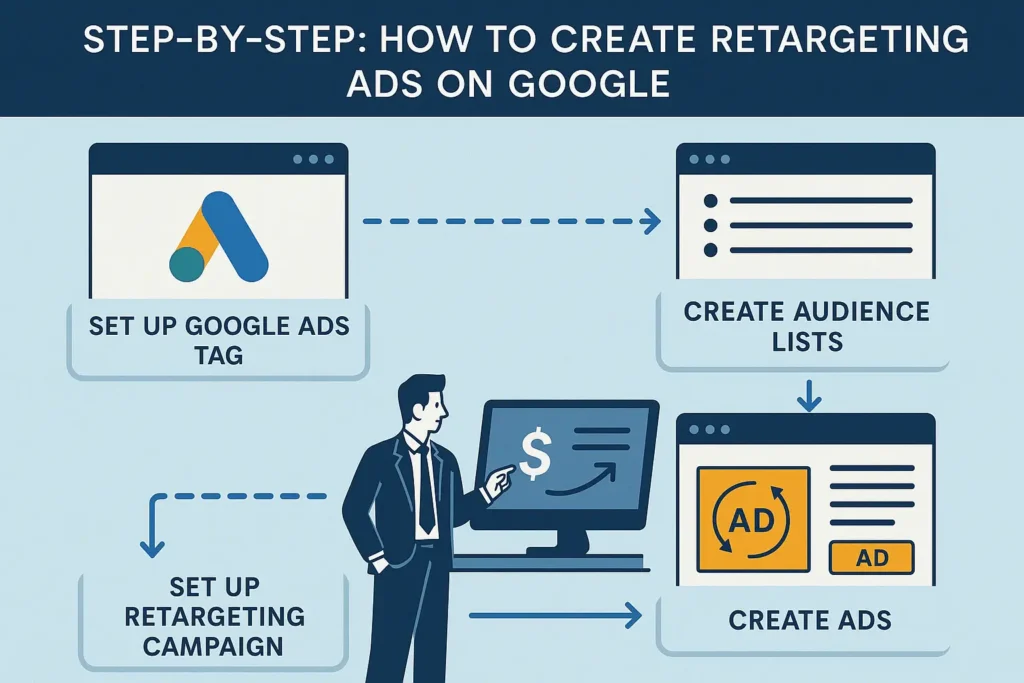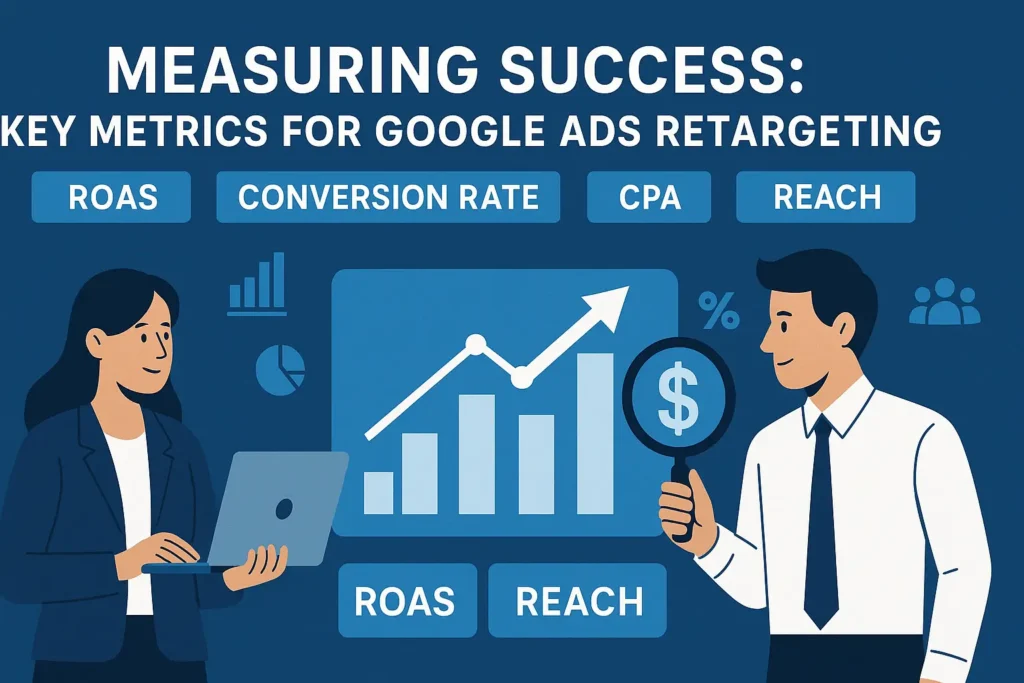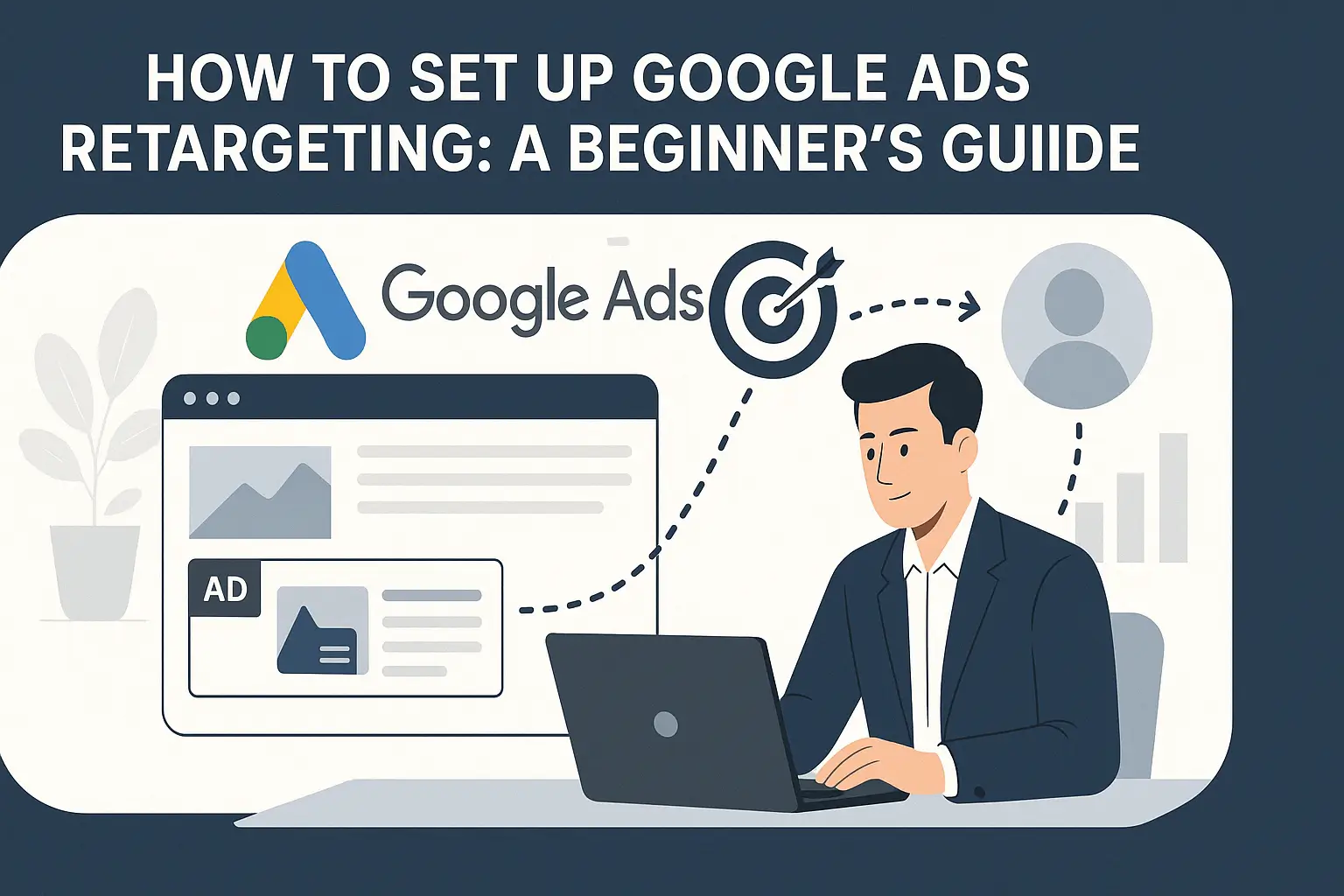Ever noticed how products seem to follow you across the internet after you’ve viewed them once? That’s not coincidence—it’s retargeting in action. As a marketing strategy that’s been driving impressive ROI for businesses of all sizes for over a decade, Google Ads retargeting has evolved into one of the most powerful tools in your digital marketing arsenal.
Having managed marketing campaigns for businesses across various industries for the past 15 years, I’ve witnessed firsthand how proper retargeting can transform conversion rates. While many business owners feel intimidated by the technical aspects of setting up Google retargeting ads, the process is surprisingly straightforward when broken down into manageable steps.
This guide walks you through everything you need to know about how to set up retargeting ads on Google, from understanding the basics to building your first campaign and optimizing for results.
What Is Google Ads Retargeting and Why Should You Use It?
Understanding Retargeting With Google Ads
Google Ads retargeting (sometimes called remarketing) is a strategy that allows you to show tailored ads to users who have previously visited your website or used your mobile app. Instead of casting a wide net and hoping to catch interested parties, retargeting focuses your advertising spend on prospects who have already demonstrated interest in your brand.
The Business Case for Google Retargeting Ads
Before diving into the technical setup, let’s consider why retargeting deserves a place in your marketing budget:
- Higher Conversion Rates: Retargeted visitors are 43% more likely to convert compared to cold traffic
- Brand Recall: Users exposed to retargeting ads show a 12% increase in brand search queries
- Cost Efficiency: Retargeting typically costs less per conversion than other digital advertising methods
- Abandoned Cart Recovery: Reduce cart abandonment rates by 6-18% with strategic retargeting
Types of Google Ads Retargeting Campaigns
Google offers several retargeting approaches to reach your audience:
| Type | Description | Best Use Case |
|---|---|---|
| Standard Retargeting | Targets all previous site visitors | Building general brand awareness |
| Dynamic Retargeting | Shows specific products users viewed | E-commerce with large product catalogs |
| Video Retargeting | Targets users who engaged with your YouTube content | Content marketers and video producers |
| Customer List Retargeting | Targets existing customers via email addresses | Repeat purchase businesses |
| Similar Audiences | Targets users similar to your existing visitors | Expanding reach to new prospects |
| App Retargeting | Targets users who installed but don’t use your app | Mobile app businesses |
Step-by-Step: How to Create Retargeting Ads on Google

Step 1: Set Up Google Ads Tag for Retargeting
The foundation of any successful Google Ads retargeting campaign is proper tag implementation. This snippet of code tracks visitor behavior and builds your retargeting audiences.
Installing the Google Ads Tag:
- Log into your Google Ads account
- Click on “Tools & Settings” in the upper right
- Under “Shared Library,” select “Audience Manager”
- Click “Audience Sources”
- Select “Google Ads Tag” (formerly known as Remarketing Tag)
- Choose between:
- Installing the tag yourself (copy/paste code)
- Using Google Tag Manager (recommended for flexibility)
- Sending instructions to your webmaster
Tag Implementation Best Practices:
- Place the global site tag on every page of your website
- Add event snippets to track specific actions (purchases, sign-ups)
- Verify proper installation using Google Tag Assistant
- Ensure compliance with relevant privacy regulations (GDPR, CCPA)
Step 2: Create Audience Lists for Your Google Retargeting Ads
Once your tag is collecting data, you’ll need to define audience segments. The more specific your segmentation, the more targeted your messaging can be.
Basic Audience Segments to Consider:
- All Website Visitors (past 30, 60, or 90 days)
- Product Page Viewers (who didn’t purchase)
- Shopping Cart Abandoners
- Past Customers (for upselling or cross-selling)
- Blog Readers (who haven’t converted)
Creating Custom Audience Lists:
- Go to “Tools & Settings” > “Audience Manager”
- Click the “+” button to create a new audience
- Select “Website Visitors”
- Define your audience parameters:
- Pages visited
- Time spent on site
- Number of pages viewed
- Specific actions taken
- Name your audience and save
Step 3: Set Up Your First Google Ads Retargeting Campaign
Now for the exciting part—building your actual campaign. This is where your retargeting strategy comes to life.
Campaign Setup Process:
- In Google Ads, click “Campaigns” > “New Campaign”
- Select your campaign goal (typically “Sales,” “Leads,” or “Website Traffic”)
- Choose a campaign type (Display Network is most common for retargeting)
- Name your campaign (include “Retargeting” for easy identification)
- Set your budget and bidding strategy
- Define campaign settings:
- Locations
- Languages
- Schedule
- Devices
Targeting Your Retargeting Audience:
- Navigate to the “Audiences” section
- Click “Browse” > “How they have interacted with your business”
- Select the audience lists you created earlier
- Consider audience exclusions (e.g., recent purchasers)
Step 4: Create Compelling Ad Creative for Retargeting
Your creative approach for retargeting should differ from your standard acquisition ads. Remember, these prospects already know your brand, so you can be more direct and specific with your messaging.
Effective Retargeting Ad Elements:
- Clear Call-to-Action: What specific action do you want them to take?
- Incentives: Special offers for returning visitors
- Urgency: Limited-time promotions or low-stock warnings
- Social Proof: Reviews or testimonials to build trust
- Personalization: Reference previous interactions when possible
Ad Format Options for Google Retargeting:
- Responsive Display Ads (automatically adapt to available ad space)
- Image Ads (static banners in various sizes)
- Video Ads (especially effective for complex products)
- Native Ads (blend with publisher content)
Advanced Strategies to Optimize Your Google Ads Retargeting Campaign

Segmentation and Personalization
The power of retargeting with Google Ads lies in your ability to deliver highly relevant messages based on specific user behaviors.
Segmentation Strategies:
- Funnel Stage Segmentation
- Top of funnel: Blog readers, homepage visitors
- Middle of funnel: Product page viewers, comparison shoppers
- Bottom of funnel: Cart abandoners, pricing page visitors
- Time-Based Segmentation
- Recent visitors (last 7 days)
- Mid-term visitors (8-30 days)
- Older visitors (31-90 days)
- Behavior-Based Segmentation
- Time on site (engaged vs. brief visitors)
- Pages viewed (categorized by interest)
- Actions taken (downloads, video views, etc.)
Frequency Capping and Burnout Prevention
One common mistake in retargeting is bombarding your audience with too many ads, leading to ad fatigue and negative brand perception.
Best Practices for Frequency Management:
- Set frequency caps at 3-5 impressions per user per day
- Implement progressive messaging that evolves over time
- Use declining frequency over the retargeting period
- Monitor ad fatigue metrics (declining CTR, increasing “Hide ad” feedback)
Cross-Device Retargeting
Modern consumers use multiple devices throughout their purchase journey. Cross-device retargeting helps maintain a cohesive experience across these touchpoints.
Setting Up Cross-Device Retargeting:
- Enable Google Signals in your Google Analytics account
- Use Google’s signed-in user data for cross-device identification
- Create device-specific messaging if appropriate (mobile vs. desktop)
- Analyze cross-device path to conversion in your reports
Measuring Success: Key Metrics for Google Ads Retargeting

Effective measurement is critical to optimizing your retargeting efforts. Here are the metrics that matter most:
Primary Performance Indicators:
- Return on Ad Spend (ROAS): Revenue generated per dollar spent on retargeting
- Conversion Rate: Percentage of retargeted users who complete desired actions
- View-Through Conversions: Conversions after users see (but don’t click) your ad
- Assisted Conversions: How retargeting contributes to conversions with other channels
- Cost Per Acquisition (CPA): Cost to acquire each customer through retargeting
- Frequency: Average number of times users see your ads
- Reach: Percentage of your audience you’re successfully retargeting
Setting Up Proper Conversion Tracking:
- Define clear conversion actions in Google Ads
- Implement conversion tracking code on conversion pages
- Set up value tracking for more accurate ROAS calculation
- Consider conversion attribution models (first-click vs. last-click)
Common Google Ads Retargeting Mistakes to Avoid
After managing countless retargeting campaigns, I’ve noticed several recurring pitfalls that businesses often encounter:
Technical Missteps:
- Improper Tag Implementation: Forgetting to place the tag on all pages or missing key events
- Cookie Consent Failures: Not accounting for users who decline cookies
- Audience List Confusion: Creating overly complex or overlapping audience segments
- Missing Exclusions: Failing to exclude converters from certain campaigns
Strategic Errors:
- Static Messaging: Using the same ads throughout the entire retargeting cycle
- Insufficient Segmentation: Treating all website visitors the same way
- Neglecting Mobile: Not optimizing for mobile experiences
- Budget Limitations: Spreading budget too thin across too many audience segments
- Failing to A/B Test: Not experimenting with different creative approaches
Privacy Considerations for Google Retargeting Ads
With increasing privacy regulations worldwide, responsible retargeting requires attention to compliance and user experience.
Privacy Best Practices:
- Implement clear cookie consent mechanisms
- Update your privacy policy to explicitly mention retargeting
- Use Google’s privacy-focused solutions as they evolve
- Respect user choices about personalized advertising
- Follow frequency capping guidelines to avoid creating negative experiences
FAQ: Google Ads Retargeting
How long should I run my Google Ads retargeting campaign?
Most retargeting campaigns perform best with a 30-90 day window. However, this varies by industry and sales cycle length. B2B products with longer consideration periods might benefit from extended windows, while impulse purchases may require shorter timeframes.
What’s the minimum traffic needed for effective retargeting?
For statistical significance, you typically need at least 1,000 monthly website visitors. With lower traffic, focus on longer membership durations for your audience lists or consider expanding your marketing efforts to increase site traffic first.
How much should I budget for Google retargeting ads?
Start with 15-25% of your total advertising budget allocated to retargeting. As you gather performance data, adjust based on comparative ROAS across channels. Many businesses find they can gradually increase retargeting budget share as they optimize campaigns.
Can I retarget users who haven’t visited my website?
Yes, through similar audiences, customer match (using email lists), or YouTube viewer retargeting. These methods allow you to reach new prospects who share characteristics with your existing audience.
How can I prevent ad fatigue in retargeting campaigns?
Use frequency capping, create multiple ad variations, implement sequential messaging that evolves over time, and exclude users who have been in your retargeting pool for extended periods.
Conclusion: Building a Sustainable Retargeting Strategy
Setting up Google Ads retargeting is just the beginning. The most successful businesses view retargeting not as a one-time campaign but as an ongoing program that continuously evolves based on performance data and changing customer behaviors.
Remember these key principles as you develop your retargeting approach:
- Start simple, then expand as you gather data
- Test continuously across audience segments and creative approaches
- Integrate retargeting with your broader marketing funnel
- Respect user privacy and preferences
- Measure beyond clicks to understand true business impact
By following the steps outlined in this guide, you’re well-equipped to create effective Google Ads retargeting campaigns that drive measurable business results. Whether you’re looking to recover abandoned carts, nurture leads, or increase customer lifetime value, retargeting with Google Ads offers a powerful and flexible solution for businesses at any stage.
Begin with a clearly defined strategy, implement proper tracking, create compelling creative, and continuously optimize based on performance data. Soon, you’ll see why retargeting consistently ranks among the highest-ROI digital marketing tactics available to today’s businesses.
